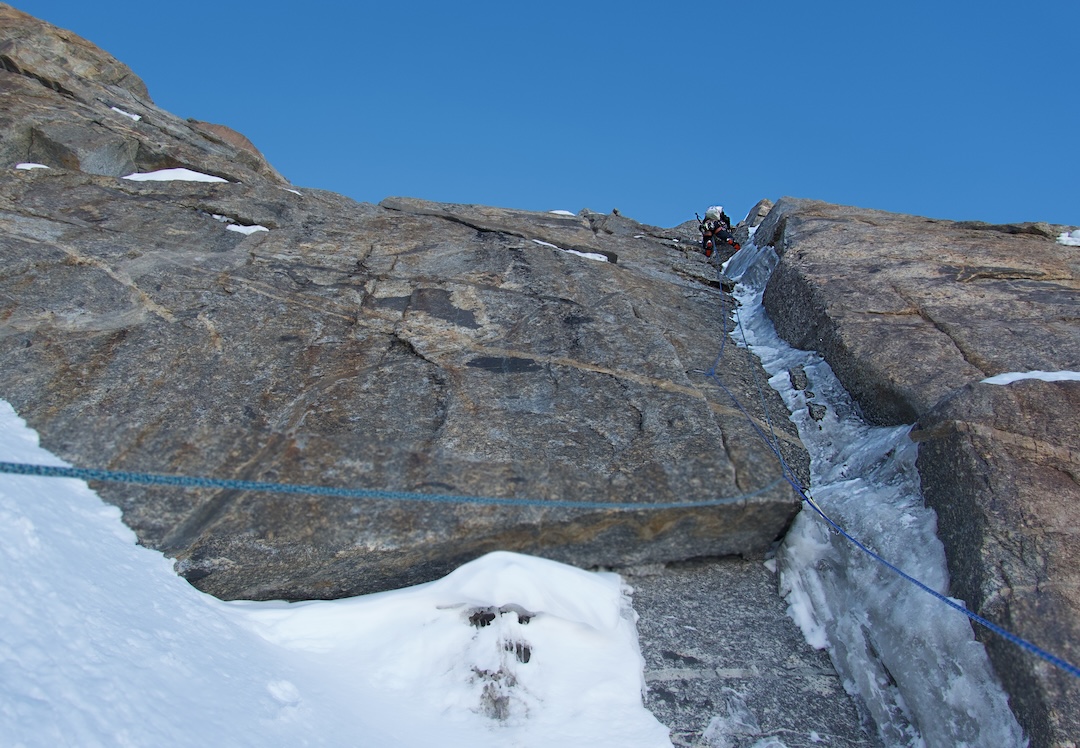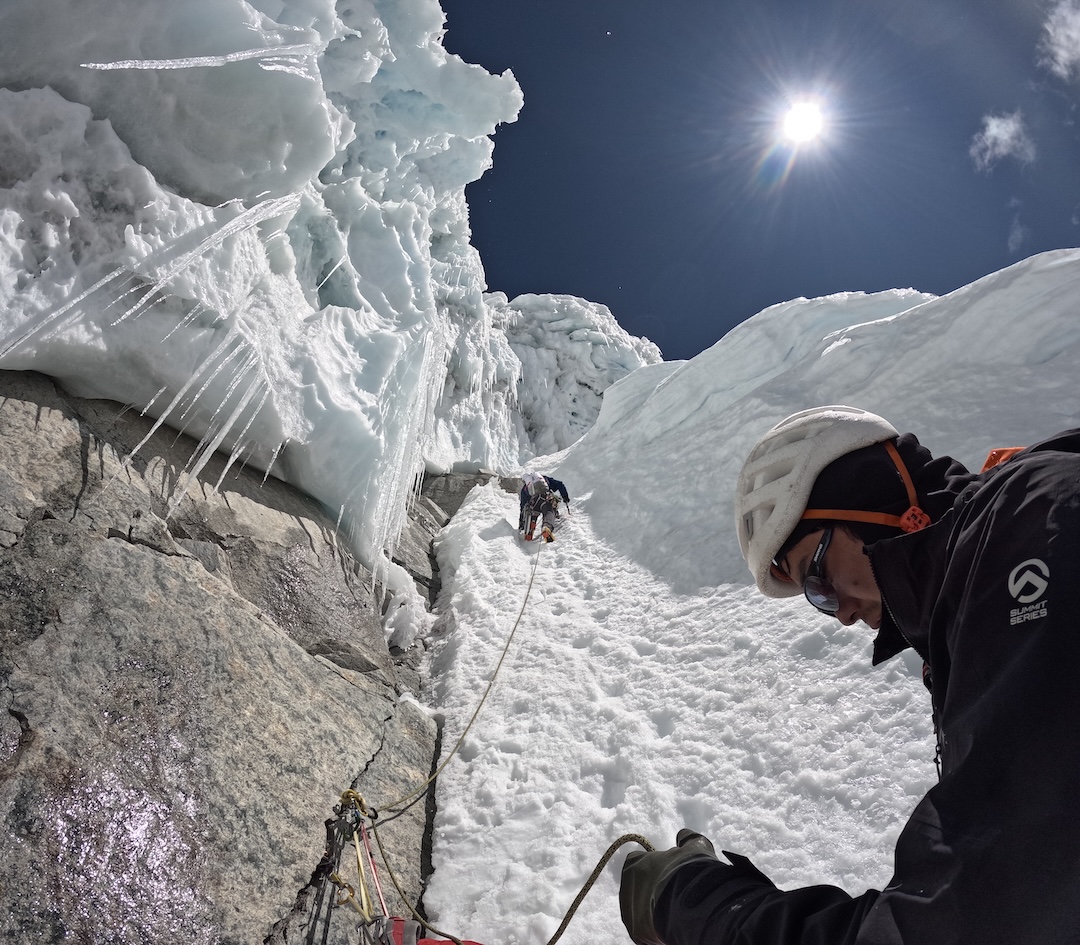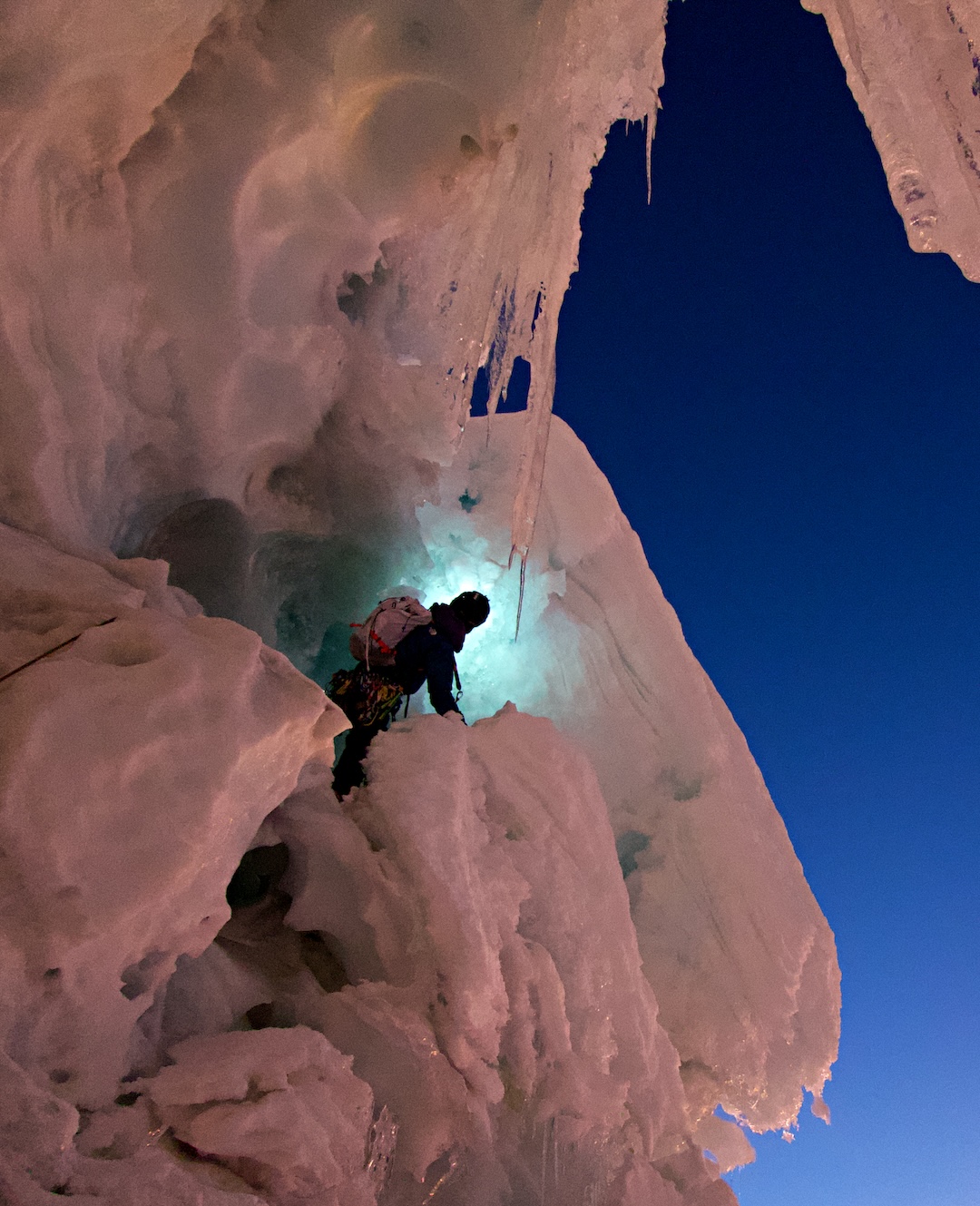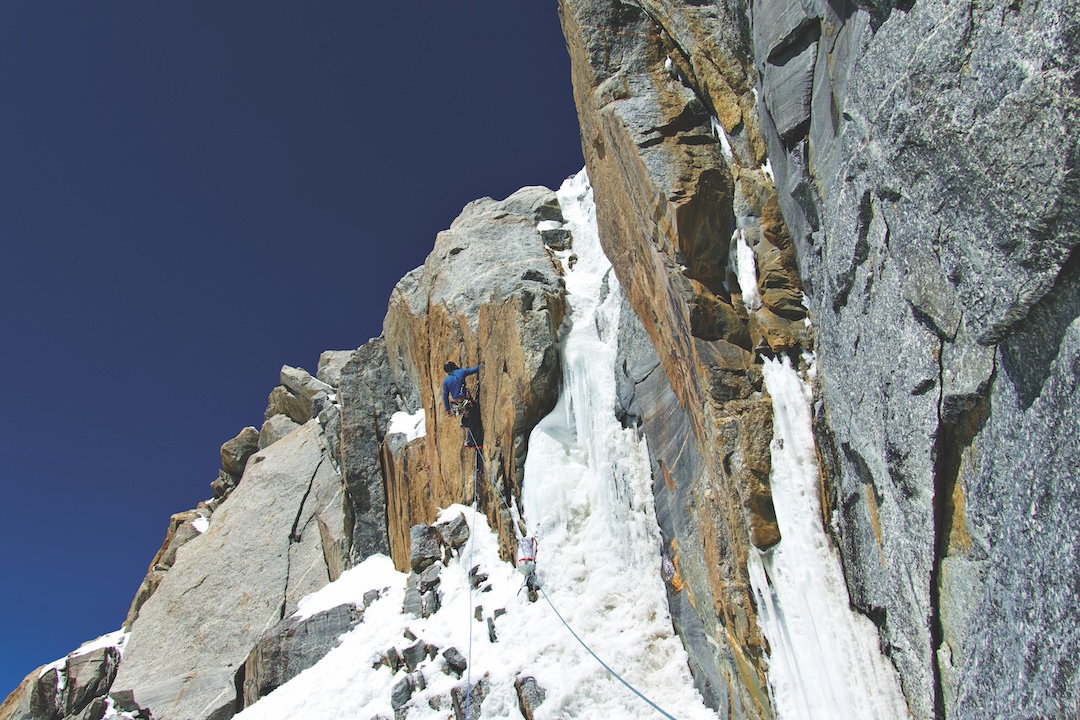Alpine Education: New Routes in Peru and Pakistan
Peru, Cordillera Blanca; Pakistan, Hindu Raj
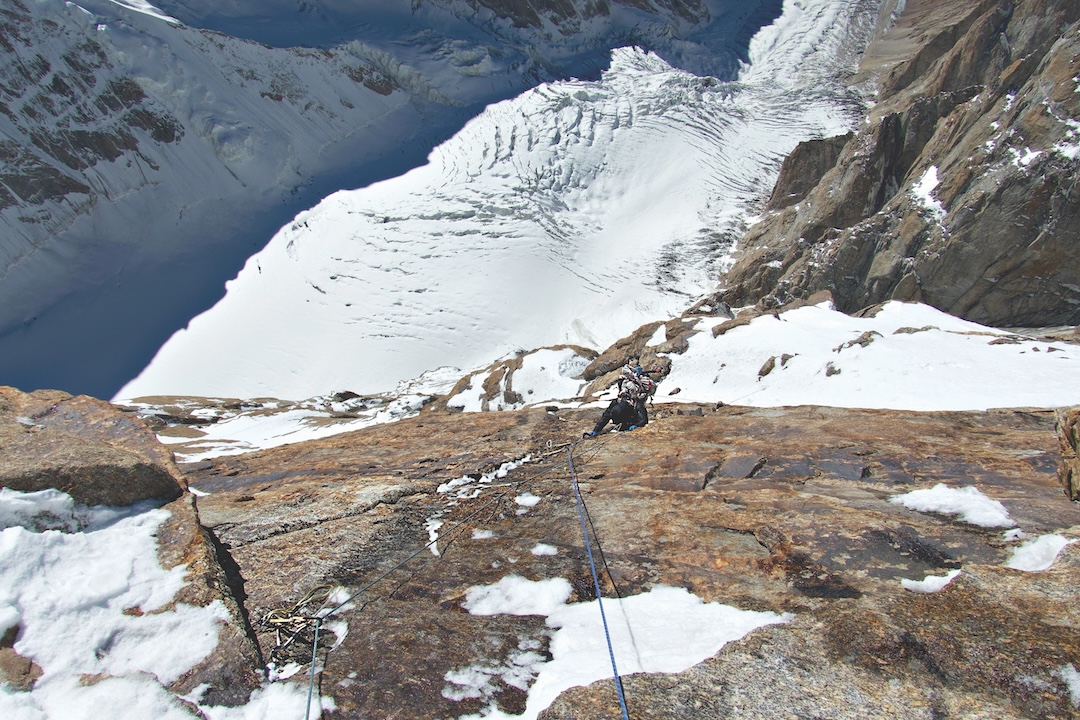
These days, becoming a great alpine climber undoubtedly requires high-level physical fitness and proficiency across various climbing styles. However, as others have said before, alpine climbing isn’t just a sport—it feels more like an art form. Physical strength is undoubtedly an asset, but no amount of athletic training will lead you to a striking mountain with limited information or to develop an eye for beautiful and climbable lines. Exceptional ability on short rock or ice climbs does not necessarily give you the composure to deal calmly with unexpected challenges, nor the communication skills to work well with porters. For me, alpine climbing is an extension of travel and adventure, a form of exploration where the puzzles of the unknown are solved step-by-step.
I began serious mountaineering around 2013 as a member of the Waseda University Alpine Club in Tokyo. For many in Japan, joining a university club is a gateway to serious climbing. It’s not uncommon for motivated students to bond across universities, forming climbing partnerships. With only about 10 to 15 alpine climbers under age 30 in Japan who actively pursue overseas expeditions, it’s a small community where news travels quickly.
As a student, I primarily undertook long expeditions in the Japanese Alps, which, though only 3,000 meters tall, are close to the sea, resulting in harsh winter weather. The approaches often are very long, and university expeditions typically are in the mountains for 12 days—much longer than my international climbs, which rarely exceed four or five bivouacs. I can confidently state that Japan is among the best places to gain experience in tough winter camping and climbing.
Simultaneously, I pursued climbing overseas, in the Dolomites, Yosemite, and Patagonia. In 2017, I participated in the first ascent of Lajo Dada (6,426m) in Nepal, which, although technically easier than my recent expeditions, involved a grueling 26-hour summit push. That climb instilled in me a deep appreciation for adventurous mountaineering without prior information, so different from the Everest “shopping mall.”
In the summer of 2022, I embarked on my first Karakoram expedition, targeting the unclimbed 7,000-meter peak of Gasherbrum VI. We only reached 6,000 meters, in part because our three-person team didn’t train together enough, and we lacked the mutual trust to support one another in an emergency.
Since then, I’ve placed greater emphasis on building strong relationships and training with partners—such as practice with simul-climbing on big routes and bivying on uncomfortable ledges—even if it means climbing less for myself. To prepare for our expeditions in 2023, Kei Narita and Yuu Nishida—two friends from my university alpine club connections—and I spent 30 days in the mountains together. The result was two big new routes: the first ascent of the north face of Ausangate (6,384m) in Peru, with Narita, and the first ascent of the northwest ridge of Ghamubar Zom V (6,400m) in Pakistan, with both Narita and Nishida.
Standing on the summit of Ghamubar Zom V in September 2023, we watched an unforgettable sunset illuminating the peaks of the Hindu Raj. Among them was Thui II, one of the most rugged and alluring mountains in the range. We quickly decided to return to this area one year later, with the aim of climbing Thui II.
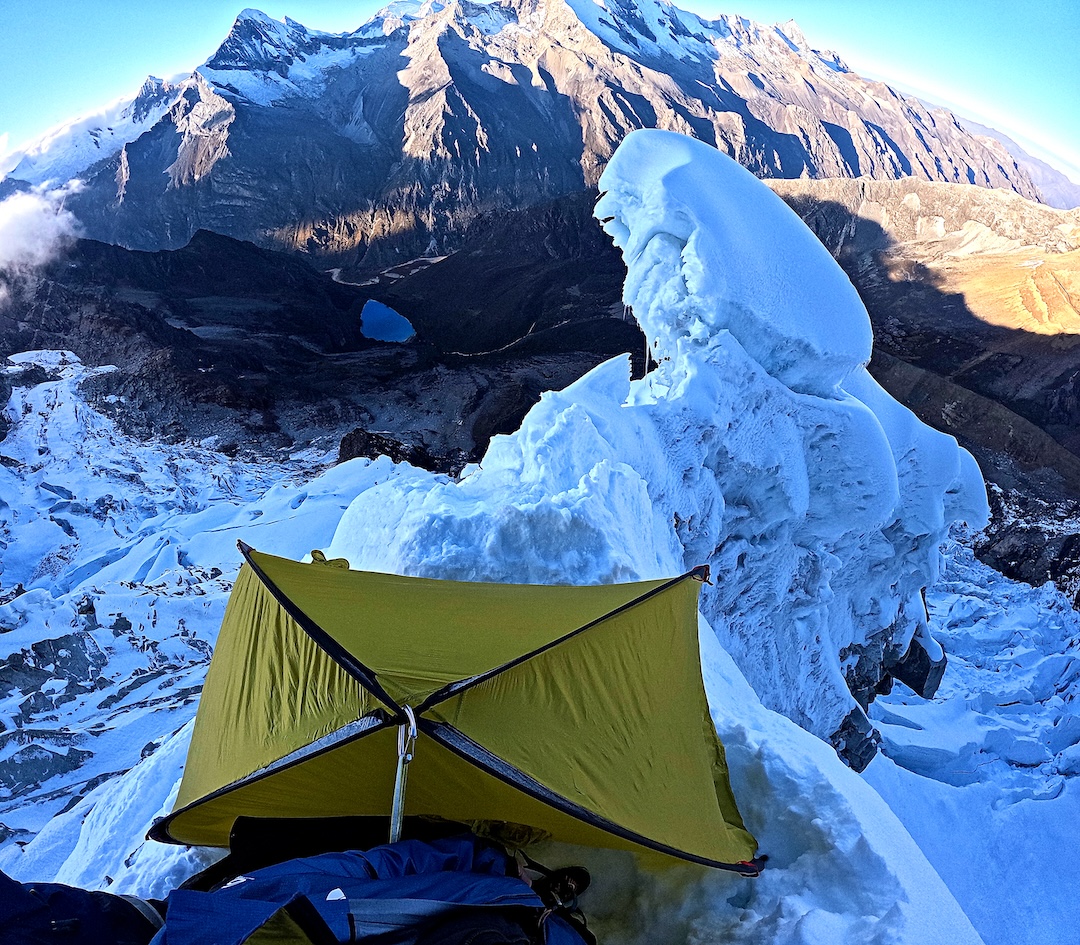
While Kei, Yuu, and I planned our trip to Pakistan in the fall, I longed for another expedition. Returning to the relatively affordable Peruvian Andes seemed like a good option. Coincidentally, Keisuke Ohkura and Kazumasa Otsubo were also considering a trip to Peru. Kei and Yuu lacked the funds for an extra trip, and although I’m certainly not well-off, I decided to go anyway, banking on the momentum from recent successes. I was 29 and well aware that the chances of finding partners for overseas expeditions soon might dwindle; these days, a lot of Japanese people quit expeditionary climbing around age 30 as they get married, have kids, or gain responsibility at work. Ohkura and Otsubo were close to my age, and we had already climbed together; leading up to the expedition, we scheduled a few sessions to practice climbing systems and team coordination.
I had climbed in southern Peru in 2023 but had yet to visit the Cordillera Blanca. Seeking a potential new line, we discovered that the south spur of Nevado Quitaraju (6,036m) was unattempted. The lack of massive overhanging seracs in the upper sections, a common feature in Peruvian mountains, added to its appeal.
The proposed line promised a mix of rock and ice on the lower face, a series of adventurous snow mushroom formations on the buttress itself, and a finish on the complex southeast ridge, above 5,750 meters. I found vague information suggesting that a 250-meter section of the southeast ridge had been climbed more than 50 years earlier, but I assumed the ridge’s conditions had changed significantly due to global warming. [The south spur of Quitaraju is on the right side of the steep south face, which has had two ascents, both to the left of the spur: by Slavko Svetičič and Žarko Trušnovec from Slovenia, in 1986, and by Nick Bullock and Al Powell from the United Kingdom, in 2001. The upper southeast ridge (confusingly called the south ridge in the original report) was climbed in 1969 by the remarkable German expedition of Klaus Schreckenbach, Bernd Schreckenbach, Hans Saler, Klaus Süssmilch, Hartmut Schmidt, and Wolfgang Weinzierl, who also climbed new routes on Artesonraju, Alpamayo, and Ausangate, as well as the first ascent of Chaupi Orco in Bolivia and various lower peaks. On Quitaraju, in a five-day traverse, they climbed the east face and upper southeast ridge and descended the west ridge.]
We began by acclimatizing on Quitaraju’s north face. Though this is one of the range’s most commonly climbed routes, the 60°–70° ice slopes were challenging under the intense sun. We headed down a little before reaching the summit.
Afterward, we returned to the town of Huaraz to regroup, then trekked back to Laguna Jatuncocha, at about 3,880 meters, to set up base camp. From there, we carried loads through thick vegetation and up scree slopes, eventually establishing an advanced base camp beyond Laguna Quitacocha at 4,800 meters. The south side of Quitaraju was markedly different from the approach to Quitaraju’s north side and popular Alpamayo, with no visible signs of human activity. Cutting through the head-high vegetation with heavy loads was grueling.
Early on June 25, under the light of the moon and headlamps, we climbed a couloir on the right side of the south spur for about 30 minutes until the angle steepened, requiring us to rope up. Otsubo led the first pitch on brittle, crackless rock, progressing slowly and carefully. It was an anxious belay, and hearing his call from the next anchor was a relief. Carrying five days of supplies, I felt the difficulty as I followed. Otsubo’s skillful lead in the dark set the tone for our expedition.
For much of the bottom section, all three of us tied into a single half rope, with one follower tied in at 50 meters and the other at the end of the rope. We climbed in blocks, alternating leads every two pitches. The system worked well, as the rock had too few cracks to set proper anchors every 60 meters efficiently, and often we’d have to clean the belay anchor and climb together until the next safe belay point. The seconds followed almost everything on the route, only jumaring one crux section on the upper ridge.
After an easy pitch, a steepening snow slope led to a mixed wall, and I took over the lead. The vertical corner above looked easy, but the holds were obscured by fresh snow, creating a challenging M6 wide section, with sugar snow complicating the mantel at the top. Even after the hard section, there were no proper placements, so I had to place some sketchy Peckers and pins as an anchor, which took time to set up. Again, we resolved to simul-climb as much as possible.
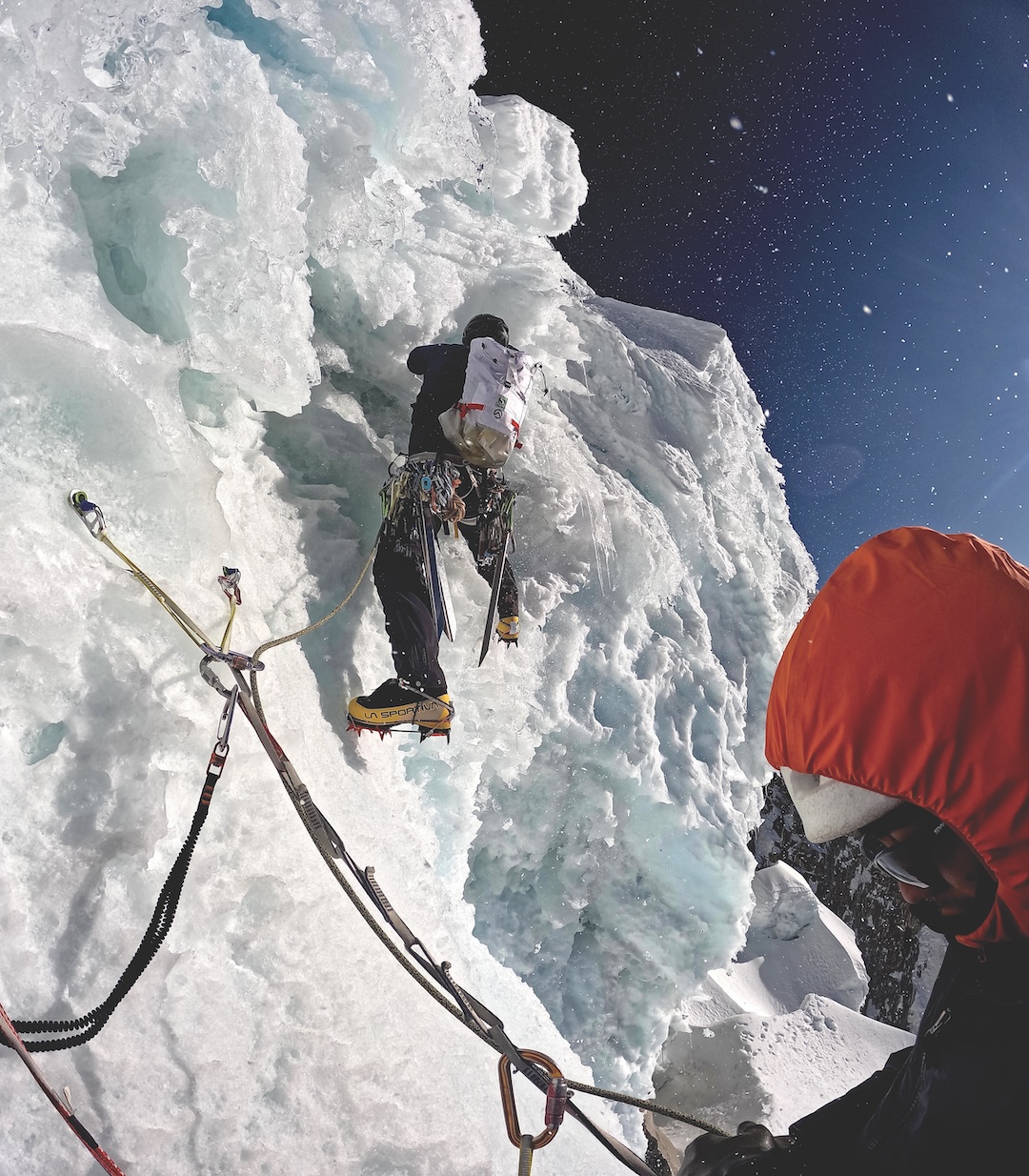
The next pitch was primarily a snow slope, but it ended with about three meters of vertical snow and ice. Despite searching carefully for protection, there was no choice but to run it out for 20 meters. I hammered in a piton—better than nothing—but it only went in halfway. This section would earn an R/X grade. With no other options, I steeled myself and climbed over the unstable vertical snow and ice.
We resumed climbing simultaneously, gaining about 120 meters in elevation. At that point, I handed the lead to Keisuke. From a distance, the next section had looked easy, but most of it was loose, powdery sugar snow. Keisuke advanced by digging for handholds, tackling some M5 mixed climbing, steadily gaining altitude. We continued rotating leaders, and to be honest, each leader’s slow progress, caused by the exertion at over 5,000 meters and the relentless snow clearing, probably made the belayers impatient. But for the leaders, the climbing was so engrossing they would lose track of time.
In the final stretch of the day, Keisuke led a long section of simul-climbing, weaving past seracs and onto a narrow ridge. We had gained about 13 to 15 rope lengths. Internally, I felt a sense of satisfaction, thinking, The technical crux is now behind us. However, it turned out the lower rock wall was merely the appetizer.
After sunset, we crawled into our tent, about a quarter of which was suspended over empty space, with our feet and heads dangling. We were so exhausted we managed to get some sleep despite the discomfort.
The second day saw the terrain shift to a steep ridgeline, similar to my experience the year before on Ghamubar Zom V. The 50°–70° snow mushrooms and the difficulty seeing the way ahead in low-angle terrain made route-finding arduous. The photos we had taken from base camp were of little help. Sugar snow was even more plentiful than on the face below.
In the afternoon, I navigated two otherworldly ice tunnels and a narrow ridge before encountering an impassable slab. After descending eight meters and traversing, we found a snow slope that just might go. Keisuke traversed a full rope length to the right and found a miraculous half-cave of ice, where we were able to set up our bivouac just before sunset. Though we had managed only six pitches all day, we were grateful for the chance to rest.
We needed to complete the complex south buttress and connect to the southeast ridge by the end of the third day, as our food and physical energy would not last much longer. Keisuke began our efforts, dancing through two delicate traverse pitches to reach a beautiful ice cave belay. Otsubo took on the third and fourth pitches. Although the snow slope appeared straightforward, it turned out to be utterly untrustworthy 70° snow. In the thin air, he painstakingly and patiently connected the line. The tension of constant route-finding never let up.
As I took over the lead again, the slope felt steeper than 80°, but the snow was firm and ice screws were solid for once, allowing steady progress. At the end of this section, I cleared a tunnel in the soft ice, crossing back to the opposite side of the ridge. The struggle with soft sugar snow continued, but finally we managed to reach the southeast ridge. After a bit of nighttime climbing, we found a bivouac site beneath a serac—the only feasible spot—and stopped there.
The next day, we hoped to cover distance quickly by simul-climbing, but day four turned out to be the hardest of the climb. First thing in the morning, as I was climbing over a mushroom, the snow and ice supporting my hands and feet gave way simultaneously, resulting in a five-meter fall. This was shocking, as I had never fallen on a winter alpine wall. There had been no warning—all four points just gave way. A poor ice screw thankfully held.
Regathering my focus, I tackled the next pitch. Placing gear in a chossy rock wall, we traversed directly beneath a massive snow mushroom. Of course, I would have preferred to avoid such a dangerous section, but it was the best option. With some grade V rock moves, I forced my way along the fragile rock. We had already come so far on the ridge that summiting and descending the opposite side was by far the best option. It began to feel more like an escape attempt than a climb.
After two easier pitches, we faced a vertical mushroom. Keisuke quickly realized his axes weren’t holding in the soft snow and ice, so he abandoned the direct approach and opted for a wide detour. Through trial and error, he connected the line, allowing us to make good progress again—only to be stopped by another massive mushroom.
This time, I was in the lead and targeted what seemed to be the most promising section of the mushroom, about 20 meters high. The wall felt vertical. I abandoned any thoughts of free climbing and equalized two okay screws to create an intermediate anchor. From there, I placed another screw and carefully eased my weight onto it, then another, and then slowly cleared the soft, shifting snow and ice near the top of the mushroom. Suddenly, I was violently ejected backward.
My mind went blank as I plunged. I saw the two highest screws pop out, but then stopped in midair after falling 15 meters. I assumed I had injured myself. However, after cautiously moving my body, I realized I was unharmed—a stroke of incredible luck. A sprain or worse in that location could have been catastrophic. What had saved me was the equalization of the final anchor and the fall through empty space, which prevented my legs from hitting solid ground.
The atmosphere was serious as Otsubo tied into the dangling rope and headed back up. I had been trying to climb a direct line for the benefit of the two followers, but Otsubo instead angled toward the right edge of the mushroom, progressing slowly, using aid on snow stakes. He eventually manteled onto the far side of the ridge and disappeared from sight, bringing an indescribable sense of relief—our line had connected. Fortunately, just beyond this, we found the flattest tent site of the entire route, providing an ideal place to bivy.
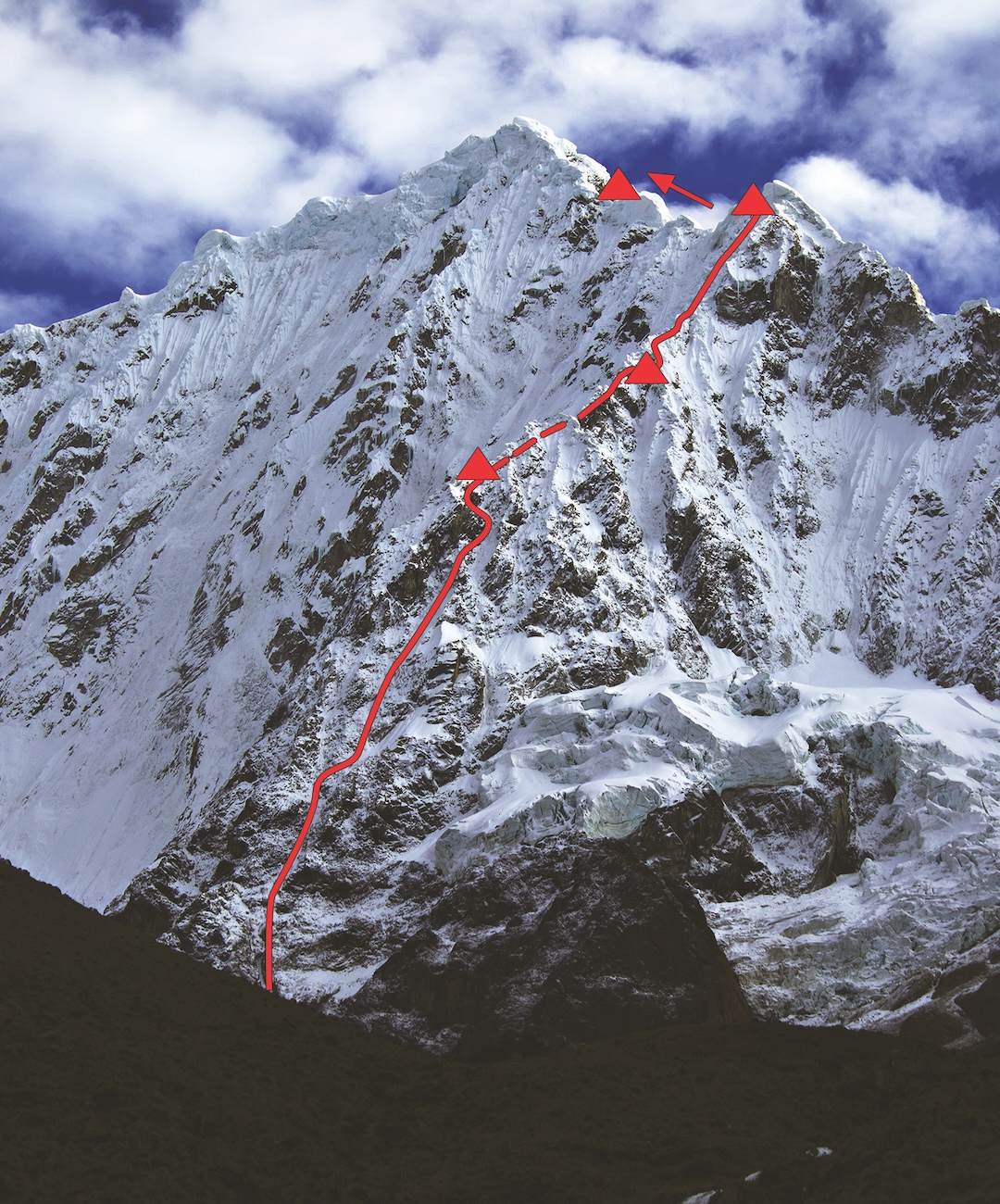
On day five, only 130 meters of elevation difference remained to the summit, though it still appeared distant. After eating the last 40 grams of freeze-dried rice, we set off, with Keisuke leading a long stretch of simul-climbing. He gained three rope lengths but was stopped again by a vertical mushroom. Here, he too fell unexpectedly due to unstable ice and was stopped by the belay anchor. This was a mountain of too many narrow escapes. Regaining composure, Keisuke managed to break through on the next attempt.
The lead passed to me, and I miraculously discovered a 60-meter gully of high-quality ice between the mushrooms, which allowed me to climb efficiently to just under the summit. At the very top, I made one unforgettable move on sugar snow to get over a meter-wide crevasse. Just before noon, I drove in two snow pickets on the summit and brought the other two to the top.
Including the simul-climbing, our ascent totaled over 40 rope lengths—a very long climb. The joy we felt on top was fleeting, as we immediately began our descent via the north face. Fatigued to the point where downclimbing was a struggle, we carefully made V-threads in the sunlit ice and rappelled. Twice, we left webbing in the ice—the only gear we left on the mountain. Frequent rockfall made the entire descent harrowing.
Climbing up to the high camp between Quitaraju and Alpamayo was excruciating, and by the time we reached the saddle it was pitch black, but the way down the glacier on the other side was familiar from our acclimatization. At Alpamayo’s base camp, we were too exhausted to pitch our tents, instead collapsing in a vacant hut. The next day, still in our high-altitude boots, we trekked down to our south face base camp.
When we looked up at the line we had drawn, all the tension and pain we had felt in the mountains transformed into beautiful memories. We called the route Dream House, after the inexpensive lodge where we stayed in Huaraz as well as the miraculous bivouac spots scattered along Quitaraju’s complex ridges.
My mind had already turned toward Pakistan. I returned to Tokyo on July 13, and just over five weeks later, on August 19, I headed to Islamabad. During the short time in between, I focused on regaining climbing fitness at the gym and crags, replenishing nutrition, and relaxing. By the time I left, I felt in excellent condition for alpine climbing.
The first ascent of Thui II was on August 4, 1978, by a British team climbing the southeast ridge, after three prior attempts that began in 1969. In the 46 years since the first ascent, no ascents of the mountain were recorded. Based on Google Earth imagery, the west face of Thui II appeared to consist of ice and rock suitable for mixed climbing all the way to the summit. We had decided to spend all of September in Pakistan’s remote northwestern frontier, just as we had for Ghamubar Zom V.
There was only a little information about the approach to Thui II’s west face via the Risht Glacier, starting in the Yarkhun Valley. A French team had visited the area a few years earlier in spring, combining skiing with climbing a mountain they called Risht Peak (ca 5,960m; see AAJ 2020).
We traveled by jeep for two days from Chitral toward the Afghan border, eventually arriving at Shost village in the Yarkhun Valley, which divides the Hindu Raj from Afghanistan’s Wakhan Corridor to the north. Beyond Shost, a rough dirt road extended another 30 minutes, and our skillful driver got us up a 35° slope to a tiny settlement, where a family generously allowed us to stay in their home. One family member, a university student, was particularly curious about us, and we shared many conversations. Their support and kindness made a lasting impression.
From the road, we hiked south up the Risht valley for six or seven hours to find a grassy spot suitable for base camp, with flat ground and a small water source, at an altitude of 4,300 meters. Four days of rain kept us resting at camp. When the weather cleared, we enjoyed a ten-day window of good weather, during which we did a five-day trip to an unnamed 6,000-meter point and spent two nights at a 5,740-meter col just north of Risht Peak.
During these acclimatization climbs, we observed Thui II and sketched out a potential route up the west face, which would gain nearly 1,500 meters. The lowest fifth of the face consisted of snowfields, followed by near-vertical ice and rock pitches, with the crux seeming to be close to the summit at 6,200 to 6,400 meters.
Back at camp, we received an inReach notification that an impending storm would last over 12 days. We entered “base camp mode,” passing time by bouldering and watching movies. At its worst, heavy snowfall buried the kitchen tent, and we briefly considered worst-case scenarios. However, as the sun eventually returned, the snow melted and revealed patches of grass. We couldn’t observe the conditions on the upper part of our planned route from base camp, and we were slightly worried about avalanches, but on September 20 we climbed to advanced base camp at 5,000 meters to launch our attempt.
We set off with four and a half days of food, two half ropes, and a small rack of cams, nuts, and pitons. We quickly climbed the initial snowfield, just above advanced base camp, then simul-climbed two long pitches, totaling about eight rope lengths, at a good pace, until reaching steeper rock and ice. The actual climbing began with melting, suspect ice. I managed it using a 30-centimeter streak of verglas and a corner. The flaring cracks seemed like they’d spit out my Tricams. I’d rate this section M4+ R.
On the following pitches, we were showered by ice melt. Luckily, there were cracks next to the ice that could be dry-tooled and jammed. Both Narita and I have climbed up to M11+ in Japan, but this pitch was rough. Above, the crack widened more than our largest cam, a number 3, but we managed. Subsequent pitches featured stacked-block rock climbing and thin ice mantels—Nishida’s leads were impressive. The last five meters seemed too rough to follow with heavy packs, and we decided on hauling.
By sunset, we had gotten to 5,810 meters. We extended a flat spot with a snow hammock to set our first bivy. We had climbed about 15 rope lengths, including the simul-climbing at the bottom. A good start.
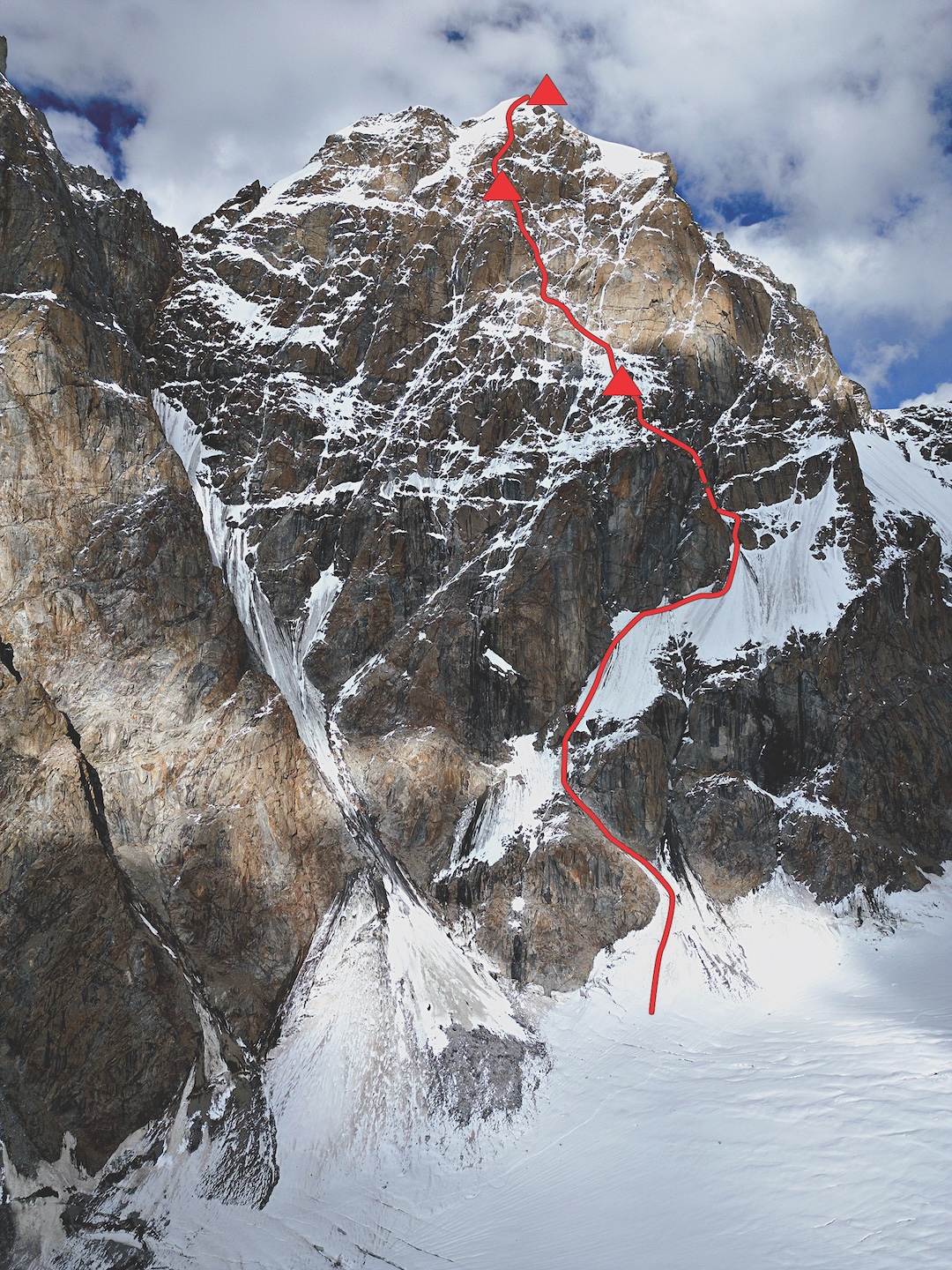
Day two began with simul-climbing three rope lengths on snow bands before being sucked into couloirs of steep ice and mixed, where we started pitching it out. The ice was solid in the morning, and we ascended seven pitches of steep, technical climbing with some hanging belays. One pitch involved climbing a vertical chimney with no ice or snow, requiring barehanded free climbing on brittle rock—around 5.8 or 5.9, with no proper gear placements.
At the end of this weak spot in the amazing headwall, we reached a slanting mini-ridge, where we decided to stop and bivy, given the accumulated fatigue and effects of altitude. Again, we expanded the spot with a snow hammock, and we retired at dusk. Even with our heads and feet not on solid ground, being able to lie flat at 6,250 meters gave us hope for the next day. It had been about 25 rope lengths up to this point.
The final 300 meters remained uncertain. We debated leaving gear at the bivouac site, in hopes of making it back that night, but chose to carry everything, as the wall looked to get even steeper. In the end, this was the right decision.
Narita got the first lead, which had a nasty downclimb with a traverse. The second pitch was a corner covered with thin verglas. Protecting the ice didn’t work, but small cracks to the side took cams. I followed the pitch and still remember the axe-torquing move at the top—roughly M6. Narita commented that doing torquing moves at 6,300 meters felt like a dream.
After climbing a short snow slope, we had the option to go left or right. Heading left would have brought us directly to a couloir and snowfield leading to the summit, but this felt unappealingly straightforward, and Nishida decided to take a peek to the right, toward the sheer wall. What initially appeared to be a sea of blank rock miraculously revealed firm, juggy holds. Nishida dry-tooled this section. At over 6,300 meters, every move was exhausting, leaving me with a headache and gasping for breath. Pitch four was another 80° mixed pitch of three-star quality. The fact that the line was connecting felt unbelievable.
On pitch five that day, I took over the lead. The nature of the wall changed drastically—I could see no corners or weak points, just a big slab. I climbed up to the base of the slab to investigate and discovered a single thin crack, running from thin hands to pinkie finger width. Traversing around it would have been challenging, so I decided to gamble and follow the thin crack.
Despite some sunlight, the cold at 6,400 meters made barehanded jamming painful, yet gloves were out of the question. About halfway up, all the footholds disappeared, forcing me to remove my crampons and transition to aiding, carefully placing small cams and Tricams. Where the crack disappeared, I free climbed short sections. Ultimately, the crack ended entirely, but there was a very thin flake about a meter to the left. Stretching my arm to its limit, I placed a 0.2 Camalot and clipped into it with a sling, cautiously shifting my weight onto it. Clearing away sugar snow and pressing against fragile rock, I manteled onto a small terrace, where I decided to end the pitch. I must have wrestled with it for over an hour at this point. Even now, I find it incredible that such a thin, hidden crack allowed us to climb directly up the slab.
I could see a good flake directly above, but I had no idea what lay beyond it. Maybe if I can’t see anything, it means the slope might ease? I climbed about five meters using good holds and saw an expanse of ice waiting ahead. It was clear this would be “blue ice torture,” but it would lead to the summit.
By now it was already past 3 p.m. Swinging our axes with full force into the hard ice, we progressed painfully slowly, but we were over 6,400 meters and couldn’t go any faster. After four pitches of this, as Nishida led, the opposite side of the mountain suddenly dropped away and he emerged into the narrow summit. The sky turned deep orange as we stood at 6,523 meters.
Battered by strong winds, we took an hour and a half to prepare for a summit bivouac. Narita and Nishida leveled the ground while I worked on melting snow. This was the flattest bivouac site of the entire climb, but the combination of intense climbing, high altitude, strong winds, and the freezing cold after sunset made for a miserable night. In total, we had climbed 32 to 34 rope lengths, with the simul-climbing included. Tomorrow we would only need to descend.
Waking on day four, we saw majestic Ghamubar Zom V, the peak we had ascended last year, towering to the southeast. We could clearly see our line, and it struck me how much longer the ridge was than I remembered. It was a moment of deep reflection.
Around 8 a.m., in a continuing cold wind, we began rappelling our ascent route. In fact, we were thankful for the relentless westerly wind, as it seemed to have blown away the heavy snow that accumulated during the storm at base camp. Using V-threads, rock horns, and a couple of pitons, we made about 23 rappels to reach the top of the initial simul-climbing section.
At this point, it was already past 7 p.m., and the sky was completely dark. However, the snow had hardened, and there were no falling rocks, so we continued, downclimbing simultaneously on one rope, reversing our ascent. Black ice appeared in places, but we carefully placed screws and cams, calmly dealing with each section. At 10 p.m., we reached the Risht Glacier. It had been a very long descent requiring full concentration.
In less than an hour, we had trekked back to ABC, where we finally removed our harnesses for the first time in four days, overwhelmed with an indescribable sense of fulfillment. We slept deeply in the denser air until 10 a.m. the next morning.
This climb reaffirmed for me how all-encompassing, free, and extraordinary alpine climbing can be. What made me especially happy was that we had managed to ascend a beautiful unclimbed wall in a single, calligraphic brushstroke from base to summit. We named the route Spider’s Thread, after the lines of ice on the wall and the countless big spiders living around the base camp.
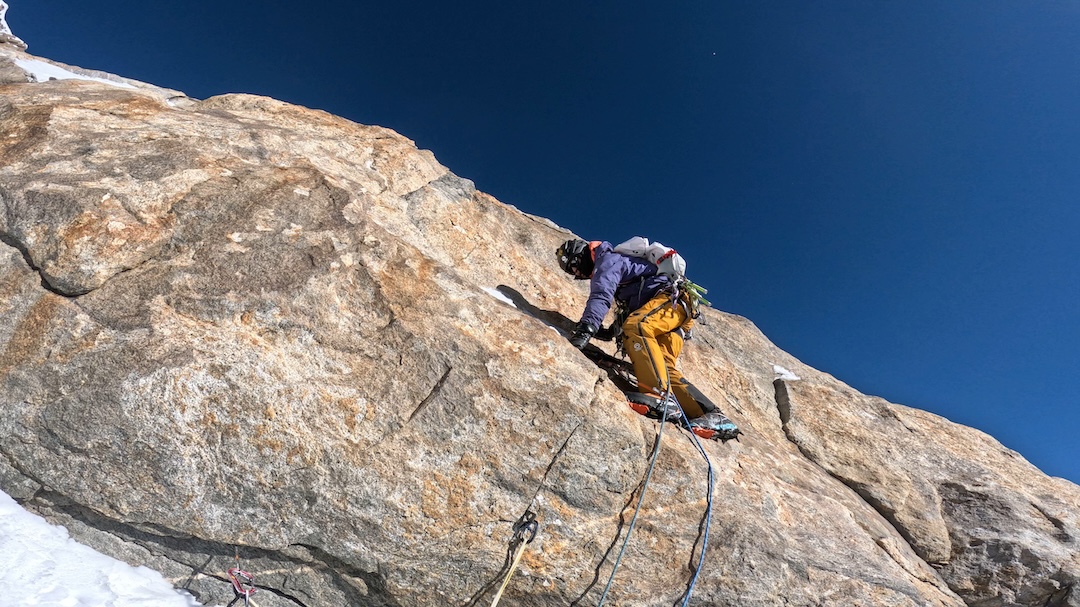
The past three years have taught me important lessons about alpine climbing in unexplored terrain and allowed me to grow as an alpinist. What did I learn on the two big climbs in 2024? There are too many things to list here, but if I were to name three, they would be:
1. Believe the route connects and keep climbing. On routes like the labyrinthine mushroom ridge of Quitaraju or the precarious aid section at 6,400 meters on Thui II, the cruxes were often hidden from below. If I had hesitated, I wouldn’t have been able to push through. Once you take a step forward, you are committed and you must trust yourself to find the route.
2. Be realistic. Conversely, it’s important to remain calm and imagine the worst-case scenario. Risks must be carefully and realistically assessed. When I suffered the 15-meter fall in Peru, I was lucky to escape without injury—I should have chosen a more cautious line.
3. Cultivate the initiative to find good unclimbed lines and go try them. I’ve had the opportunity to experience first ascents on five 6,000-meter peaks. But I can say it is not easy to identify good objectives. Living in Japan, far from the highest mountains of Asia or South America, I have to leverage tools like the internet and Google Earth to identify objectives and imagine unclimbed lines. After that, the important part is having the maximum commitment to go and see what’s there. You won’t know what it’s like until you try.
Drawing on the invaluable experiences I gained from climbing Quitaraju and Thui II in 2024, I hope to continue discovering and pursuing creative alpine routes and expanding my understanding of the unknown.
SUMMARY: New route up the south spur and southeast ridge of Nevado Quitaraju (6,036m) in the Cordillera Blanca, Peru, June 25–29, 2024, by Keisuke Ohkura, Kazumasa Otsubo, and Yudai Suzuki, Japan. The route is called Dream House (1,240m, VI M6 AI5+ R/X A2); the descent was by the north face. New route up the west face of Thui II (6,523m) in the Hindu Raj of Pakistan, September 21–24, 2024, by Kei Narita, Yuu Nishida, and Yudai Suzuki, with descent by the same line. They called the route Spider’s Thread (1,450m, ED+ M7 A2).
ABOUT THE AUTHOR: Born in 1994 in Tokyo, Yudai Suzuki works, climbs, and skis as much as he can when not on expeditions. He works as a coach for Waseda University’s alpine club, as an athlete for The North Face, and as a ski guide, mountain cameraman, and lecturer.
This story was translated from Japanese by Heikki Ruuska.


